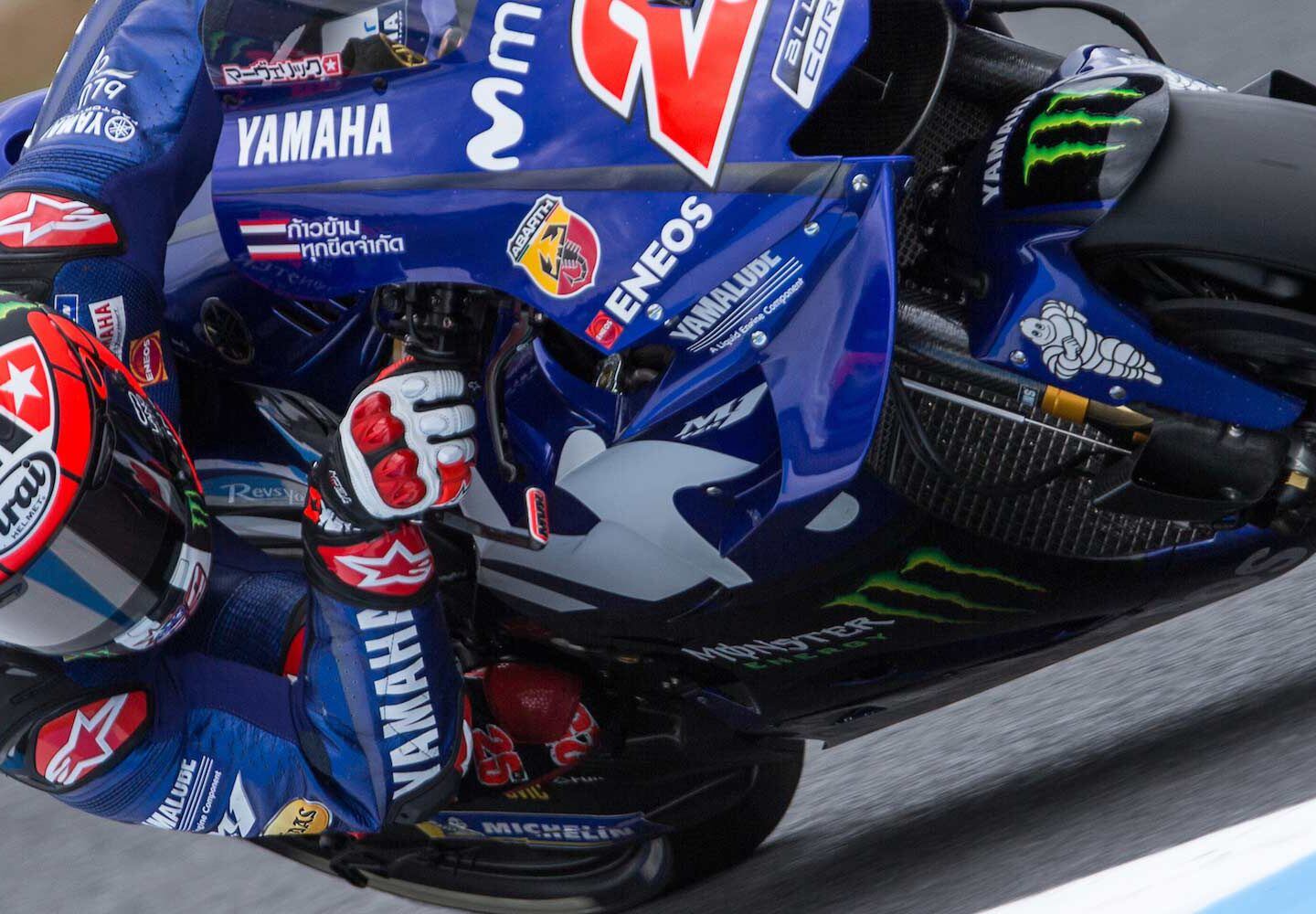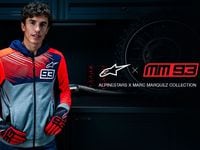Beginning in 2019, Fédération Internationale de Motocyclisme (FIM) homologated helmets will be mandatory for all riders participating in Grand Prix roadracing, namely MotoGP, Moto2, and Moto3. Identified by a hologram accompanied by a scannable QR code, this new official stamp of approval will supersede existing internationally recognized helmet safety standards, including ECE, JIS, and Snell.
FIM Marketing Director Fabio Muner has played a leading role in the creation of this new helmet standard. Hired 18 months ago after more than 17 years with Aprilia, Pirelli, and most recently AGV/Dainese (“two wheels to the bone,” he says), Muner brought a deep appreciation and understanding of motorcycling—street, off-road, and competition—to the Swiss-based governing body. I spoke with Muner about the new standard.
Full-face helmets used in MotoGP already conform to internationally recognized standards. What prompted this new certification?
We believed that not all helmets arriving in the world championship were at a high quality level as far as safety. We saw after crashes different reactions from product to product. Sometimes young brands were not so well-developed; they just entered the championship with a big budget to sponsor riders. Sponsorship is part of our world, but the first point is to deliver the best product on the market in MotoGP, Moto2, and Moto3.
We have to check exactly the helmets supplied to our athletes. The process started with the main brands of the motorcycle industry to define a testing protocol. There have been some negotiations because we wanted to go even further in terms of energy absorption, but finally we found an agreement on certain parameters and values, and we started with this process as we promised almost one and a half years ago.
Why is this the FIM’s concern?
Because we are responsible for what happens in the Grand Prix paddock. From an ethical point of view, from an investment point of view, the riders are our interest. Also, safety is one of the main pillars of the FIM. It is part of our strategy, our approach, so we want to control exactly what arrives in this special market.
We understand we have to put in place new tests to evaluate features of the helmet—the main two are penetration and rotational impact—that are not yet foreseen by the other standards. The existing international standards (ECE, JIS, and Snell) remain a requirement for a helmet to be eligible for FIM homologation. Probably we are leading a little bit the process and in the near future we will be also accepted by the commercial standards.
Where will the helmet testing and homologation take place?
The Impact Laboratory of the University of Zaragoza in Spain is one of our partners. We received a lot of compliments from the helmet manufacturers because the lab is well organized and structured. We are also speaking with other laboratories that want to start working with the FIM. It is important for us to have a laboratory network to absorb the testing workload and confirm results where needed.
There are two more laboratories that have asked to be in the system. We are defining the protocol with them and the schedule for evaluations. We know them, and they already work with the industry and test according to ECE. For the brands that have already been tested and met the homologation, we have delivered the labels to them.
We would like put in place a similar process for off-road helmets and for when we are doing even bigger jobs with painting, barriers, etc. There are a lot of products to be tested and homologated by the FIM. And so probably we will need a bigger network of laboratories and partners to check all these.
Do you believe the FIM standard is higher than that of other standards currently in existence?
Yes, 100 percent. This is just the first step in this process. We have to stimulate the industry to increase the level of safety. But this is normal. The helmets of 2018 are not the same as helmets of just five years ago, thanks to the technology, to the investment of the different companies. I strongly believe that racing is the main platform to achieve different results as far as fuel consumption, horsepower, aerodynamics, safety, tire wear, etc.
I think what we experience here in this paddock can benefit different industries. We discovered this several times in MotoGP, where you have prototypes with high performance, high speed, high heat. Something that can work very well in Moto3 may not work very well in MotoGP. But if it works in MotoGP, for sure it will work in Moto2, Moto3, and other categories.
When helmet manufacturers apply for homologation, do you request multiple helmets? Do you go to their factories and pull random samples?
Usually, there are three parties in contact: the FIM, the laboratory, and the manufacturer. The manufacturers send helmets directly to the lab with all of the documents and information. FIM Technical Commission Coordinator Erica Manfredi has led this process from the beginning. She is an engineer based for several years in Switzerland, and thanks to her knowledge and deep commitment, the FIM Racing Homologation Programme (FRHP) will finally see the light.
The homologation is per size, and 10 samples are requested per size. Each helmet undergoes not just one but several impact tests (high- and low-speed linear impact, oblique impact, penetration). Paint and comfort padding of the homologated helmets are recorded, but they can be modified by the manufacturer and the homologation will remain valid.
When you were developing this process, did you communicate with other sports, such as the NFL, NHL, or professional cycling?
You named American pro sports that I love, but we don’t have special contact with them. I can say that motorcycling is really different for the energies that the product and head can suffer in a crash. For sure, the impact in American football can be very heavy, but crashing a motorcycle is really different because of the speed, energy, weight, etc.
Will an FIM-approved helmet look different than existing models?
To achieve a certain performance, every brand has different designs and technology inside the helmet. We are not judging their approaches. We are just checking the figures after the test. We defined the protocol with them, but how the brands protect the riders is up to them. Our job is to understand how good the products are that arrive in this racing series.
When you created this new homologation process, did you consider other features, such as spoilers or vents?
Yes, we wanted to test the helmets as they are used in racing. All our tests are done with spoilers and other features for aerodynamics that the racing services apply. Some brands have very clean shapes without any features, but sometimes they use additional plastic parts for racing. For us, it is important to test and verify that these products are safe in the configuration pro riders use. If the brands want to test a new configuration of the spoilers or vents, they will have to test those helmets with the new configuration.
Does the FIM charge helmet manufacturers for testing?
Yes. We are investing in materials, in processes, in databases, etc. The brands pay the laboratory for the tests and also for the protocol that we are using. All approved helmets will have a hologram sticker on the chinstrap. Also, the QR code present on this label is a link to a database, where the manufacturers can put all the information they want: the name and model of the product; a link to the website pages dedicated to that helmet or the technology if they want to explain or promote it; and the guarantee of the homologation.
Are you working with non-helmet manufacturers, such as MIPS, to understand new technology that might benefit future generations of racers?
We are not working with companies that also supply technology to helmet manufacturers because we don’t want to suggest different approaches or policies. We just want to verify the results. Then everybody can have his own idea about the shape of the helmet, the technology of the EPS, MIPS, etc. It’s really up to them. We just want to raise the bar for safety and to verify that everything landing here is worthy of world-championship riders.
Do you expect this new standard will also reach street and trackday riders? If the helmet is good enough for Marc Márquez or Valentino Rossi, for example, then it must good enough for me.
Our main goal with this standard is to protect the riders in this paddock, but I believe it will be of great importance for the manufacturers to sell the same products to the end consumer. For sure, some of the brands—I cannot say 100 percent—will sell exactly the same helmet worn by the pro riders. We will see FIM hologram labels on dealership shelves.
I believe it is also important for the manufacturers to distinguish the best helmet in their product lineups and also between direct competitors that achieve this homologation. I think this is beneficial for everybody. It will also be a reward for them after making such an investment to achieve this homologation.











/cloudfront-us-east-1.images.arcpublishing.com/octane/DGNYC3UYRSL2PLL3I2DZGMIKAA.jpg)
/cloudfront-us-east-1.images.arcpublishing.com/octane/6IQU3AD3IWSI6IGGT22IWJAMUA.jpg)
/cloudfront-us-east-1.images.arcpublishing.com/octane/MPHXIIV54NAU5L6E4SYZHCXVRM.jpg)



/cloudfront-us-east-1.images.arcpublishing.com/octane/WYXFHF4ZOBBTXELIZDB2FJXU64.jpg)
/cloudfront-us-east-1.images.arcpublishing.com/octane/K5FNV7ONUVDXJJ2H5BIWUGBGTI.jpg)
/cloudfront-us-east-1.images.arcpublishing.com/octane/MGVKP5VTNJHQ7FWNAHIWX4OHO4.jpg)
/cloudfront-us-east-1.images.arcpublishing.com/octane/6JEYTSIZQRHPJAVVPRLWZU63UM.jpg)
/cloudfront-us-east-1.images.arcpublishing.com/octane/XJU3VJZSDFEOVDBJTRXTTLTN5U.jpg)

/cloudfront-us-east-1.images.arcpublishing.com/octane/A6O3TEZF45BVFG2KKOUMPWEYM4.jpg)
/cloudfront-us-east-1.images.arcpublishing.com/octane/MHVFMH2YN5DT3EOZPLXKNFP3VM.jpg)
/cloudfront-us-east-1.images.arcpublishing.com/octane/VILA5L7CTBGOJGDKM2YAOCR6VU.jpg)
/cloudfront-us-east-1.images.arcpublishing.com/octane/GZMZRTYRS5A75G2EJDDGXLJEEE.jpg)
/cloudfront-us-east-1.images.arcpublishing.com/octane/6KWAL3TFNJBGTJMJSKQ2C6I3IY.jpg)
/cloudfront-us-east-1.images.arcpublishing.com/octane/GK5I5R3X7JCABGCKAKT4XY2K7U.jpg)


/cloudfront-us-east-1.images.arcpublishing.com/octane/RGUT3Y65IFGDFMLHQ3U7G5UUQE.jpg)

/cloudfront-us-east-1.images.arcpublishing.com/octane/37CSHD6CKRHYXHRB67EOLDS6XM.jpg)
/cloudfront-us-east-1.images.arcpublishing.com/octane/FYB7GKDGLVE3JKXMM75JTG2RYA.jpg)
/cloudfront-us-east-1.images.arcpublishing.com/octane/3ECVMM622VAZHIOLI6Q6ILWULU.jpg)
